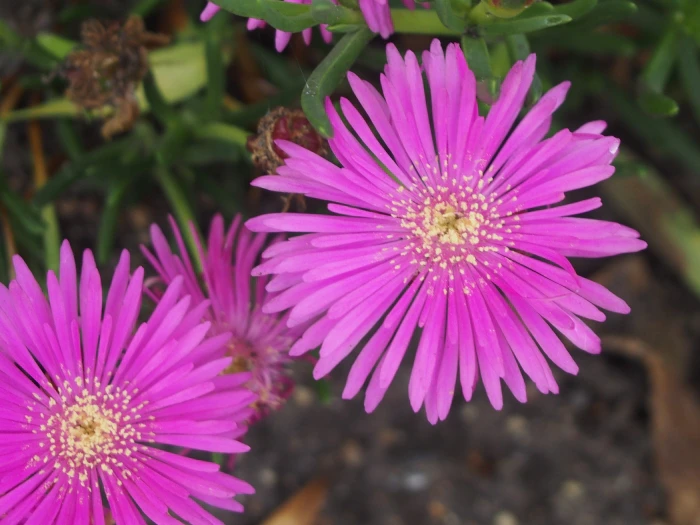Hardy Ice Plant
(Delosperma cooperi)
Hardy Ice Plant (Delosperma cooperi)
/
/

Agnieszka Kwiecień, Nova
CC BY-SA 4.0
Image By:
Agnieszka Kwiecień, Nova
Recorded By:
Copyright:
CC BY-SA 4.0
Copyright Notice:
Photo by: Agnieszka Kwiecień, Nova | License Type: CC BY-SA 4.0 | License URL: https://creativecommons.org/licenses/by-sa/4.0 | Uploader: Nova | Publisher: Wikimedia Commons | Title: Delosperma_cooperi_Delosperma_Coopera_2019-09-15_02.jpg | Notes: User created page with UploadWizard |































Estimated Native Range
Climate Requirements for Henderson, Nevada
| This Plant | Your Site | Plant Suitability for Your Location | ||
|---|---|---|---|---|
| • Precipitation | 10" - 63" | 5" | Your precipitation may be insufficient for this plant. Irrigate N" / year. | Irrigate N" / year |
| • High Temp. | 55°F - 93°F | 104°F | Your summers may be too hot for this plant. | Too hot |
| • Low Temp. | 16°F - 53°F | 36°F | Your winter temperatures are normal for this plant | Excellent |
This plant should grow well at your location with about N inches per year (Y minutes per month) of irrigation.
Summary
Delosperma cooperi, commonly known as Hardy Ice Plant, is an evergreen succulent native to South Africa, specifically the Free State and Lesotho, where it thrives in rocky outcrops and grasslands. It forms a dense mat-like groundcover reaching approximately 10–15 cm (4–6 in) tall, with fleshy, linear leaves up to 1.5 inches long and trailing stems that can recover rapidly after disturbance. The plant is renowned for its brilliant vermillion, magenta, or pink flowers that bloom profusely from June to October, often covering the entire planting area and creating a stunning "pink carpet" effect. The flowers are particularly showy, attracting pollinators and providing a long-lasting display of color.
Hardy Ice Plant is valued for its drought tolerance, low maintenance requirements, and ability to withstand cold temperatures down to −20 °F (−29 °C), making it a versatile choice for Mediterranean climates and colder regions like Denver, Colorado, and Chicago, Illinois. The leaves can turn red in cold winter temperatures, adding to its ornamental appeal. It is commonly used in urban landscaping, rock gardens, as a ground cover, and in containers on terraces and patios. For optimal growth, it requires full sun, very low to low water, and well-draining soil. While it is not known for serious pest or disease problems, it can suffer from root rot if overwatered or planted in poorly draining soils.CC BY-SA 4.0
Hardy Ice Plant is valued for its drought tolerance, low maintenance requirements, and ability to withstand cold temperatures down to −20 °F (−29 °C), making it a versatile choice for Mediterranean climates and colder regions like Denver, Colorado, and Chicago, Illinois. The leaves can turn red in cold winter temperatures, adding to its ornamental appeal. It is commonly used in urban landscaping, rock gardens, as a ground cover, and in containers on terraces and patios. For optimal growth, it requires full sun, very low to low water, and well-draining soil. While it is not known for serious pest or disease problems, it can suffer from root rot if overwatered or planted in poorly draining soils.CC BY-SA 4.0
Plant Description
- Plant Type: Succulent
- Height: 0.3-0.5 feet
- Width: 1-2 feet
- Growth Rate: Moderate
- Flower Color: Pink, Purple
- Flowering Season: Summer, Fall, Spring
- Leaf Retention: Evergreen
Growth Requirements
- Sun: Full Sun
- Water: Very Low, Low
- Drainage: Fast
Common Uses
Bank Stabilization, Bee Garden, Bird Garden, Border Plant, Butterfly Garden, Deer Resistant, Drought Tolerant, Erosion Control, Fire Resistant, Groundcover, Hummingbird Garden, Low Maintenance, Potted Plant, Rabbit Resistant, Rock Garden, Showy Flowers, Street Planting
Natural Habitat
Rocky outcrops and grasslands in South Africa
Other Names
Common Names: Trailing Iceplant, Pink Carpet, Röd Frövisare
Scientific Names: Delosperma cooperi, Mesembryanthemum cooperi, Delosperma cooperi f. bicolor
GBIF Accepted Name: Delosperma cooperi (Hook.fil.) L.Bolus